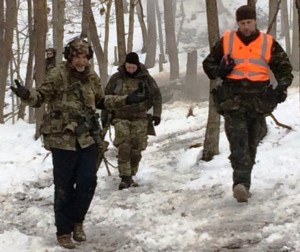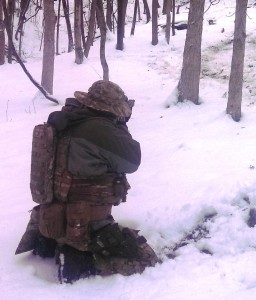AAR #3: DEC 14/15 CRCD – D Close
D-Close: In the middle, above.
AAR “Operation Winter Palace”
14/15 Dec 2013
Those in the partisan/prepper training business must have some understanding of the fickle nature of their participants. They balance the needs of family, finances and liberty to obtain training that might possibly save their own lives and the lives of others. There is no retirement program, no health care. The government doesn’t provide their weapon or ammunition. Their logistics chain is linked to home and hearth. When the weather turns a less than optimal hue, it places stress on this organic support. Cancellations must be anticipated. At MVT 14/15 Dec CRCD class, in the face of mountainous winter conditions, we gained men! Tyranny, take note and despair!
Having participated in a summer session, there were marked differences due to weather and some more subtle, due to experience and refinement.
For those preparing for year round combat operational capability, one must attend training even during adverse environment conditions. Although not advertised as a requirement, West Virginia in December would certainly fit the bill as elevations of 1200-1500 ft MSL are common. Max communicated to our group that training was a go and winter clothing was required.
There are areas in which the self-reliant patriot (SRP) may try to “fly” Economy rather than First class. Winter clothing is not one of those areas. Max is big on the smock concept and it works for his loadout, to be sure. For myself, wearing a full set of level IV body armor, a carrier and attached MOLLE required a similar concept. With less access to the front of the smock, I went with the Blackhawk Warriorwear nylon shell over a fleece liner. My base layer consisted of Merino wool top and bottom, covered with a Multicam combat shirt as an extra layer. The long johns were pricey, $95 for the lower and $75 for the upper. They were fantastic. Next day I wore instead the USMC type poly base layer; It sucked.
Weight considerations: TAG plate carrier, plates, four loaded mags, BK2 knife, 2 smoke grenades, and a few other SMOLES items weighed in the neighborhood of 35 lbs. Rifle was 7.0 plus a Burris MTAC at 1.9 and a 30 round mag at 1.6. Throw a battle belt with dump pouch, BOK, PVS-14 and a Glock 22+1 mag in there and a grand total combat weight of…268ish. Now that is a bunch to be running around with in the snow, especially uphill, down to prone, breaking contact drills, assault a bunker, etc. Night of Day 1 was interesting from a pain management perspective.
So that segs into something that Max and many others have been talking about. Fitness is key. There is a requirement to remain fit throughout the combat effective life of the SRP. If this exercise had been longer term, illness comes into play. Your fitness level directly impacts your resistance level for disease prevention or injury.
Footing and infantry movement techniques (IMT) were certainly impacted by the weather. It directly impacted the speed for RTR and putting rounds on target. The snow is a double edged sword as it may help with concealment after the initial volley and soften the impact of the ground on your laden frame. React to contact meant that team members who had to advance up hill or down, needed to use care to avoid slipping and keeping weapons from eating snow and ice during a fall. Hint: KEEP A CLEANING ROD ON YOUR COMBAT LOAD OR ATTACHED TO YOUR RIFLE.
Malfunctions increased due to the conditions. Wet and icy seem to be tricky. I used a Bushmaster lower and an upper from ARD. I had a few “failure to extract” casings that needed a pull on the charging handle to get back in the fight. You experts out there can tell me why. Out of 671 rounds fired, this may have happened four times. The bottom line is that the SRP needs to be ready to clear a malfunction in a hurry, especially in a fight when team members are moving to cover and you are supposed to be laying down effective suppressive fire.
For those of you who are contemplating a second run through Max’s CRCD, the benefit is repitition of basic skills and the development of situational awareness during a fight. Another concern for the SRP is the use of IMT during RTR drills. One of my training goals was to utilize IMT during RTR to a greater extent and improve my survivability and lethality. As I became more familiar with the desired reaction during contact drills, my utilization of IMT became more effective and I was able to expand awareness of cover and concealment.
CRCD offers a safe and effective means of developing team combat skills. For those lucky patriots who can muster a fire team at home, this training is invaluable and difficult to reproduce on a local level. The use of remotely operated pop-up targets is effective in developing patrolling and react to contact drills. Working with our ad hoc fire teams of SRPs from places far and wide proves that like minded Americans can come together for common defense on short notice and perform effectively.
MVT CRCD has evolved into a highly efficient combat team tactics class. Tactical combat casualty care training was provided by a student with extensive experience in emergency trauma medicine. At the same time, Max was leading individual students on the “Jungle Walk” exercise. His patience level is amazing as he engages students with a wide range of ability.
The instructor steers away from basic weapon handling review. The SRD who attends this class must have basic knowledge on safety, marksmanship and malfunction clearing technique in order to achieve maximum benefit from the class. He must show up with a zeroed rifle and enough skill to engage targets and change mags from the prone position.
What level of capability does this training bestow? It certainly gives an intro to a basic infantry skill set that can be further developed and passed on to other team members. In a “without rule of law” (WROL) scenario, trained personnel working in teams should be capable of defending and if necessary, counter-attacking a similar sized enemy. If faced with a violent and numerically superior foe, the use of coordinated and effective fires by trained team members will prove effective in repulsing attacks against important targets. Logistics then becomes the limiting factor with the supply of ammunition, food, water and medical support key to winning the long term fight.
Ultimately, leadership will determine if battles are won or lost. Will SRPs develop an effective leadership cadre to engage threats throughout a range of scenarios? Will SRPs employ leaders who have mastered the combat skills necessary and can lead their teams through the agony of armed conflict? With basic blocks like CRCD and more advanced patrol classes, MVT and others like him make the development of effective small unit leaders possible so that self-reliant patriots can win the fight. To lead, you must first DO.
– D Close



